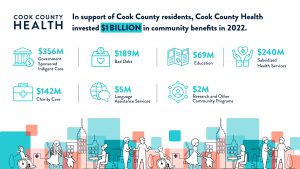
As an essential community asset, Cook County Health is proud to invest in the health of those whom we serve. We do this by providing free and discounted medical care, offering public health services, funding community-based resources, educating the next generation of health care providers and more. In all, Cook County Health provided $1 billion in community benefits in 2022.
The $1 billion investment includes the services Cook County Health provides as a health system and public health authority. Cook County Health’s two hospitals provide approximately 40% of the free medical care offered by all hospitals in the county.
Our mission at Cook County Health is to establish universal access to the world’s best care and health services for all Cook County residents, regardless of the ability to pay, so all may live their healthiest life. We seek to create partnerships with other health providers and communities to enhance the health of the public. We also advocate for policies that promote the physical, mental and social well-being of the people of Cook County.
It is an honor to provide these vital community benefits to support the health and wellbeing of the residents of Cook County.
Definitions
- Bad Debts. The bad debt expense resulting from the extension of credit for services the hospital provided for which payment was expected but not received.
- Donations. Cash and in-kind donations such as the value of meeting space, equipment, and personnel to assist other community health care providers, social service agencies and organizations.
- Education. Costs incurred for hospital-based educational programs such as medical residency and internships and nursing. radiology technician and physical therapy programs, reduced by direct medical education funding from third-party payer reimbursement, offsite rotation revenue, fees charged, etc. Community health education and wellness programs should be reported under Subsidized Health Services section.
- Government Sponsored Indigent Health Care. Unreimbursed cost of Medicare, Medicaid, and other federal, State, or local indigent health care programs, eligibility for which is based on financial need. Includes both inpatient and outpatient services. In calculating this cost, hospitals should apply a total cost-to-charge ratio to obtain costs, unless the hospital has an alternative method for determining costs, then deduct any revenues that were received for such services.
- Language Assistant Services. Unreimbursed actual costs pertaining to language assistance service such as salaries and benefits of translators, costs of translation services provided via phone and costs of forms, notices and brochures provided in languages other than English, offset by any revenue received for these services.
- Research. Cost of research activities conducted primarily to advance medical or health care services, including clinical drug trials, demonstration projects for alternative delivery systems, disease-specific research, etc. This portion of the report should include only actual costs not covered by grant funding or donations.
- Subsidized Health Services. Subsidized health services for which the hospital, in response to community need, must subsidize from other revenue sources. It includes, but is not limited to, such services as emergency and trauma care, neonatal intensive care, community health clinics, and collaborative efforts with local government or private agencies to prevent illness and improve wellness, such as immunization programs. Includes specialty services that yield a financial loss such as rehabilitation, burn care, substance abuse, HIV/AIDS, geriatric, pediatric, clinics, hospice, physician referral service, ambulance and programs to prevent illness or injury and improve wellness such as community health screenings, immunization programs, health education, counseling and support groups, poison control, etc. Hospitals should determine the financial loss by calculating the costs of staff, materials, equipment, space, etc., offset by any third-party payment, patient fees, or donations.
- Volunteer Services. Voluntary activities provided by hospital employees and volunteers in connection with a hospital’s Community Benefits Program that take place as the result of a formal hospital initiative to organize or promote voluntary participation in the activity. Value of volunteer time is to be calculated as the number of volunteer hours multiplied by minimum wage.


